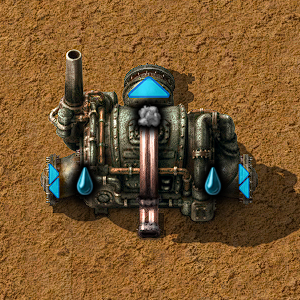Heat exchanger
| Heat exchanger |
- Base game
- Space Age mod
|
Recipe |
|||||||||||||
| +++ → | |||||||||||||
|
Total raw |
|||||||||||||
| +++ | |||||||||||||
|
Map color |
|||||||||||||
|
Fluid storage volume |
Input: 200 |
||||||||||||
|
Health |
|
||||||||||||
|
Resistances |
Explosion: 0/30% |
||||||||||||
|
Stack size |
50 |
||||||||||||
|
25 (0.5 stacks) |
|||||||||||||
|
Dimensions |
2×3 |
||||||||||||
|
Energy consumption |
|
||||||||||||
|
Heat output |
|
||||||||||||
|
Maximum temperature |
1000 °C |
||||||||||||
|
Fluid consumption |
|
||||||||||||
|
Mining time |
0.1 |
||||||||||||
|
Prototype type |
|||||||||||||
|
Internal name |
heat-exchanger |
||||||||||||
|
Required technologies |
|||||||||||||
|
Produced by |
|||||||||||||
The heat exchanger exchanges heat between a heat source and a fluid. It is usually used together with a nuclear reactor and steam turbines.
Heat exchangers will not produce steam until they reach 500°C. Heat exchangers have a heat capacity of 1 MJ/C. Thus, they can buffer 500 MJ of heat energy across their working range of 500C to 1000C, and require 485 MJ of energy to warm up from 15C to 500C when initially placed.
Heat exchangers produce 103 steam/second when they are a least 500°C warm. This can be calculated by using the energy consumption: 1 Heat exchanger consumes 10MW, so it's putting 10,000,000 joule of energy into heating water/steam per second. To heat up 1 unit of water 1 degree, 200 joules are needed, so the heat exchanger is heating up 50,000°C in total. But the water only gets heated up from 15°C to 500°C, so by 485°C. So the 50,000°C are enough to heat up 103 units of steam per second, since 50,000 / 485 = 103.09.
History
- 0.15.0:
- Introduced
